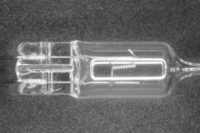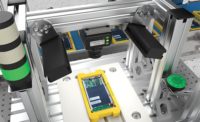Machine vision is an integral part of the manufacturing process for many different industries. Manufacturers ensure the safety, consistency and integrity of the products produced through proper inspection, while being
assured that defective parts are rejected from the production line. Inspection allows manufacturers the ability to keep a hand on the pulse of their manufacturing processes, allowing them to correct issues before they potentially become costly.
Today’s machine vision inspection systems perform 100% inspection at line speeds of over 3,000 containers per minute while automatically rejecting defects. They can detect many smaller and even “hidden” significant defects that no other method can.
Manufacturers continually integrate the latest technology to increase their production output and be as efficient and successful as possible. Their key objectives are to minimize the amount of costly system implementation trial and error, and choose both a path and system that will be able to serve their changing needs as seamlessly as possible.
Investing in a machine vision inspection system is a decision that is not taken lightly. These systems have a direct impact on waste, product quality and company reputation. The first step in finding the right type of system for your operation is knowing what to look for.
Multiple-Unit Inspection
The can-making industry has been following a trend of utilizing multiple cameras with a single inspection controller. This approach has been successfully implemented in the recent years. Today, these single-processor inspection systems are the proven baseline technology.
In a multiple-unit inspection system, several cameras run from one central processing unit (CPU). They can be positioned on the same line working fairly close to one another to inspect a single product, such as a beverage can. Digital cameras can be positioned on multiple lanes while still being controlled by one CPU.
These cameras are closely related statistically from a process perspective. This central computing method offers the canmaker easily accessed, detailed data collection and process information.
Multiple inspection systems are sometimes chosen when there are tight space limitations but data correlation is still needed. For example, several cameras can be installed in a necker (a complex machine which creates the “neck” of a beverage can), with each camera passing along information to the next (Body Maker ID, what lacquer gun was used, what body defects it has, what neck defects it has). All of this data is correlated together for the canmaker to examine the part as a whole, throughout the entire can-making process.
Due to the sharing of resources, a multiple-unit inspection system can be more cost effective per node.
While the sharing of resources can add to the benefits of choosing this system, there can also be disadvantages to consider.
For example, consider an application with four cameras spread across four production lanes, all controlled by one central processing unit (CPU). If the CPU fails for any number of reasons (such as a camera malfunction, remote system failure, or an operator error), production on all four lines must be stopped for the problem to be fixed. Once solved, the system must be restarted, all for the benefit of a single lane.
Also, with this type of inspection system, there are limits to the number of nodes that can be utilized for a given CPU. These limits are due to either processing power or hardware limitations.
While multiple-unit inspection systems can be relatively more cost effective, the distribution of camera nodes across many lanes is labor intensive, requiring expensive wiring and conduit. This wiring can be prone to noise and failure if installed incorrectly.
An Autonomous Alternative
The concept of an autonomous, distributed vision system has been around since the beginning of machine vision, but it has been only recently that improvements in technology have allowed the industry to capitalize on this idea for highly sophisticated application-specific machines. Utilizing self-learning algorithms, pattern locating tools and highly accurate colorimetric measurements, the era of sophisticated stand-alone inspection has arrived.
Utilizing a single data source coupled to a single processor brings forth new efficiencies throughout the entire container manufacturing process. Line placement and installation become simpler and faster, and possibly more affordable for manufacturers. Instead of losing production on all four lanes as in the previous examples, only one lane would be interrupted in the case of a CPU or camera malfunction.
Moreover, single-unit inspection can reduce the amount of maintenance required. By combining lighting and processing into a single enclosure, the installation, mounting, cabling, and labor are also simplified.
A self-contained inspection unit can be installed almost anywhere on a production line, so that redundancy can be employed if desired, and cost savings can be realized every step of the way. Canmakers are not bound by the position or distance between their inspection units because the units run independently; previously, canmakers could only plan installations in terms of “I can only put my control cabinet here, and so I can only put my system here or there.”
These units provide value as a front-end inspection tool. If a manufacturer has an issue on the front-end, they generally still end up putting a lot of value-added steps into that product as it travels through the end of the process. By identifying and removing defective parts earlier, they avoid wasting coating, tooling and metal later.
Depending on the amount of nodes, autonomous inspection systems can be more expensive to purchase than central computing systems. But, having the flexibility of mounting locations and transference of data over Wi-Fi makes these systems an excellent option.
A Partner You Can Trust
In addition to choosing the type of system that works best for their application, choosing the vision inspection system manufacturer is equally important. Manufacturers look for companies that continually bring new ideas to the market.
No matter what system is chosen, manufacturers need the continued support of an expert partner for training, service and maintenance. It is important to evaluate service capabilities very closely; it is one of the key factors that will determine whether the system returns value for years to come, or becomes a drain on resources.
Partners that offer global service and support ensure that they can get to the facility quickly when on-site consultation is needed. Availability of replacement parts and whether 24-hour customer service is available should also be considered.
The Choice is Yours
Machine vision inspection is technology that is an integral part of the manufacturing process. Choosing application-specific inspection equipment ensures that the manufacturers invest wisely, provide the highest possible quality for their customers and improve the overall manufacturing process.
|
TECH TIPS
|





